Un afectuoso saludo a toda la comunidad de Foodies Bee Hive. Uno de los ingredientes que acostumbramos a usar en casa, para la elaboración de las hallacas, son los vegetales encurtidos, o simplemente encurtidos, como los conocemos comúnmente en mi pueblo, una conserva o pickle que incluye una mezcla de zanahorias, pepinos, cebolla y coliflor, conservados en vinagre, que es común en los supermercados venezolanos. El caso es que, desde hace ya varios años, hemos venido haciendo nuestros propios encurtidos, tanto como preparativo previo a la elaboración de las hallacas, como para el consumo de mi esposa, que por alguna razón que desconozco, los come como si fueran cotufas (palomitas de maíz).
Entonces, en esta publicación, les traigo el procedimiento que usamos para elaborar estas conservas en vinagre. Espero que les agrade.
Los ingredientes en si son un poco al ojo, porque todo dependerá de que tanto les guste cada uno de los vegetales que conforma la mezcla, o incluso que quieren conservar, pues pueden usar esta misma técnica para vegetales diferentes a los que usaré aquí.
A warm greeting to the entire community of Foodies Bee Hive. One of the ingredients that we usually use at home, for the preparation of hallacas, are pickled vegetables, or simply pickles, as we commonly know them in my town, a pickle that includes a mixture of carrots, cucumbers, onion and cauliflower, preserved in vinegar, which is common in Venezuelan supermarkets. The thing is that, for several years now, we have been making our own pickles, both as a preparation prior to making hallacas, and for my wife's consumption, who for some reason unknown to me, eats them as if they were cotufas (popcorn).
So, in this publication, I bring you the procedure we use to elaborate these preserves in vinegar. I hope you like it.
The ingredients themselves are a bit to the eye, because everything will depend on how much you like each of the vegetables that make up the mixture, or even that you want to preserve, because you can use this same technique for different vegetables than the ones I will use here.
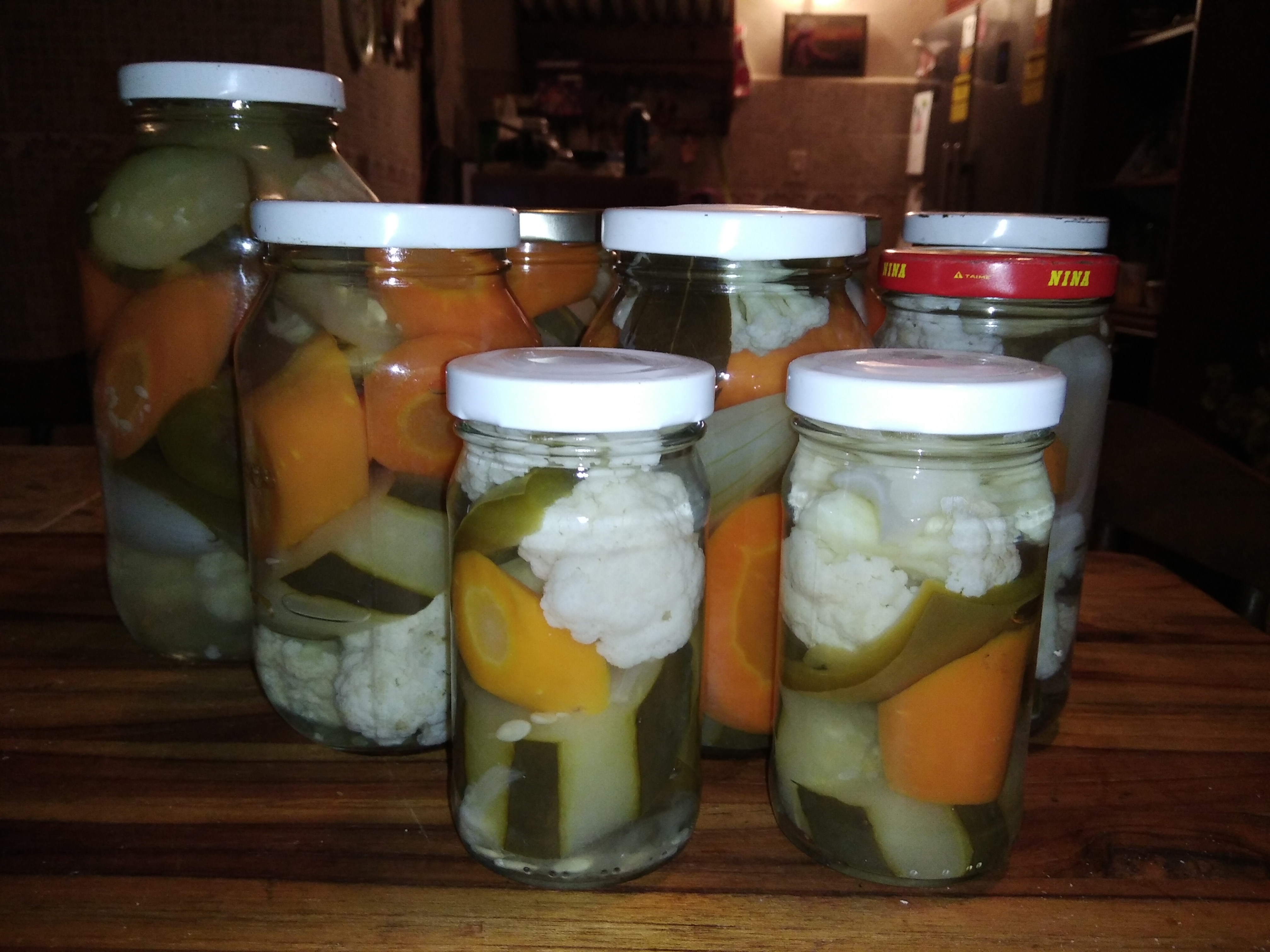

Ingredientes:
Vegetales:
- 4 zanahorias grades
- 3 pepinos grandes
- 1 coliflor de tamaño mediano
- 2 cebollas medianas
- 1 pimentón grande
Para encurtir:
- 4 litros de agua
- 1 litro de vinagre
- 3 cucharadas de sal
- 3 cucharadas de azúcar
- algunas hojas de laurel
Para el envasado
- Frascos de vidrio con tapa metálica de cierre hermético, (de esas que hacen un característico sonido de "pop", cuando se abren por primera vez)
- Agua suficiente
- Cucharon, pinzas y espumadera de acero inoxidable.
Ingredients:
Vegetables:
- 4 large carrots
- 3 large cucumbers
- 1 medium size cauliflower
- 2 medium onions
- 1 large bell pepper
For pickling:
- 4 liters of water
- 1 liter of vinegar
- 3 tablespoons salt
- 3 tablespoons sugar
- some bay leaves
For canning
- Glass jars with hermetic metal lids (the kind that make a characteristic "pop" sound when opened for the first time).
- Sufficient water
- Stainless steel spoon, tongs and skimmer.

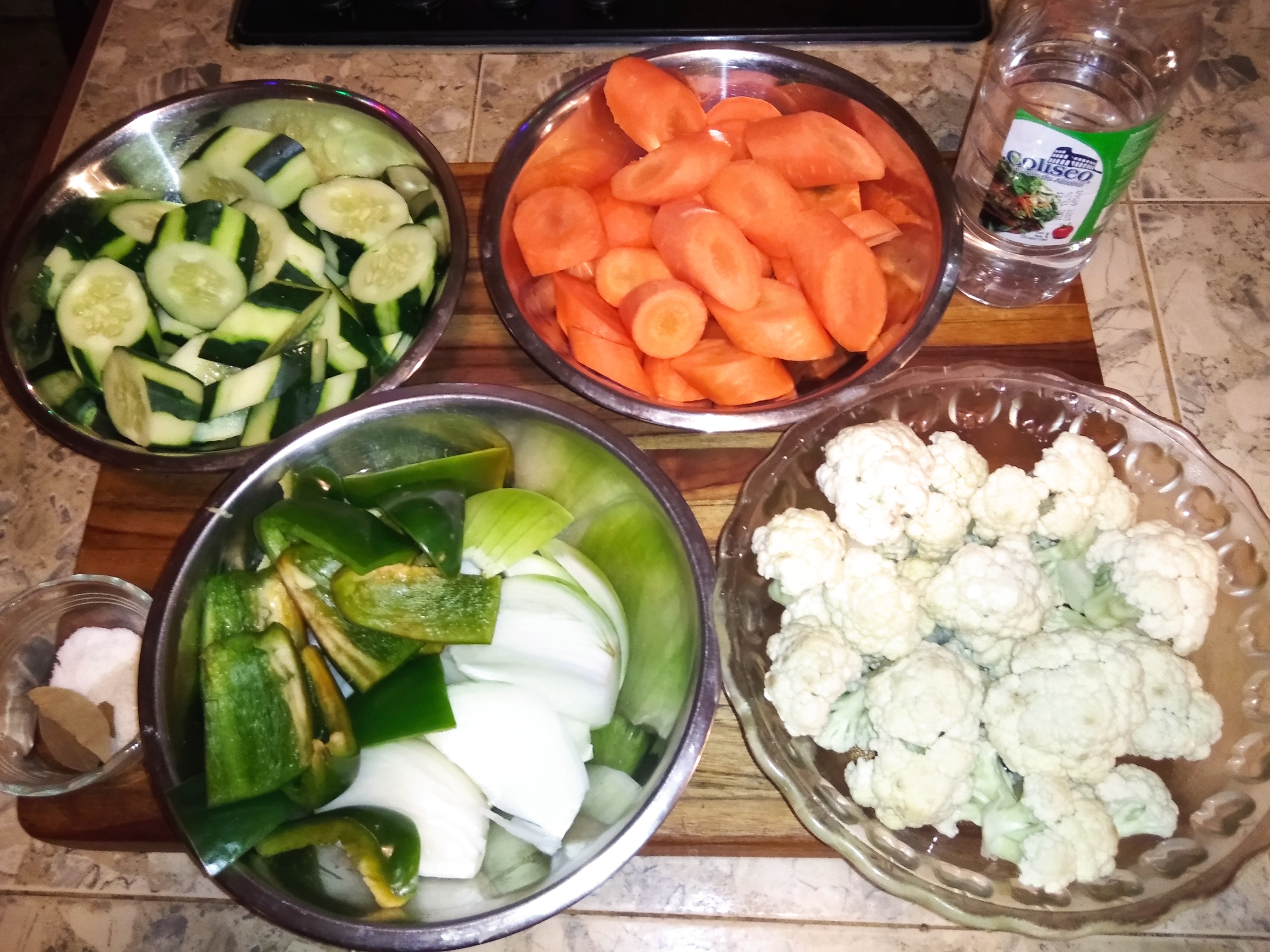
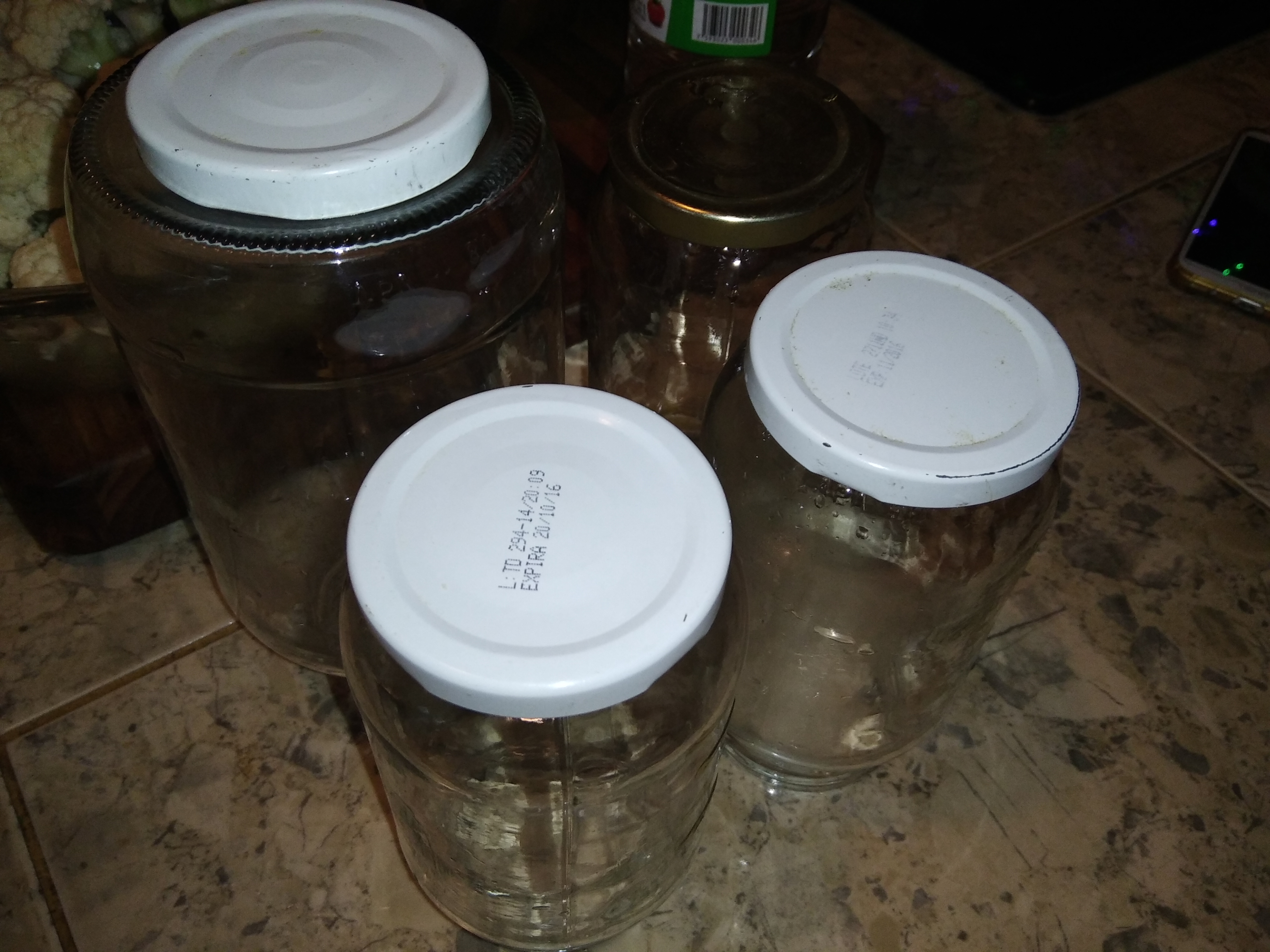

Paso 1
Lo primero que deberíamos hacer es empezar por la esterilización de los frascos, que en realidad continuará durante todo el proceso de elaboración. Así que en una olla con tapa, bastante grande y profunda, como para poder introducir varios de los frascos que usaremos, pondremos a hervir abundante agua, como para sumergirlos junto a sus tapas.
Mientras el agua entra en hervor, lavaremos adecuadamente los frascos y sus tapas y enjuagaremos, para que no les queden restos de jabón, escurriremos y luego los introduciremos en la olla, separados de sus tapas, cuando el agua esté hirviendo, procurando que queden completamente sumergidos en ella. Después de introducirlos el agua reducirá su hervor, así que, dejaremos que empiece a hervir nuevamente y a partir de este momento, deberemos dejar los frascos y sus tapas al menos por 10 minutos en el agua hirviendo.
Respecto al tiempo, yo no me preocupo mucho por llevarle la cuenta, pues lo que normalmente hago es que, después de que el agua hierve, meto los frascos y los dejo ahí, mientras hago el resto del procedimiento, y los saco del agua sólo al momento en que voy a empezar a llenarlos con los vegetales. Lo cual da un tiempo más que suficiente como para que estén completamente esterilizados.
Otra forma de esterilizar los frascos sería usando el horno de microondas, y aunque más riesgosa, resulta también más rápida y práctica. Consiste en, después de lavarlos, enjuagarlos y escurrirlos adecuadamente, justo antes de empezar a envasar, introducirlos en el microondas, sin sus tapas, por unos dos o tres minutos a potencia máxima, luego por separado, hacer lo mismo con las tapas, manteniéndolas separadas y sin que lleguen a tocar las paredes del microondas, justo antes de colocarlas. Sin embargo, hay que tener mucho cuidado al hacer esto, pues los frascos se calientan mucho más que en el agua, y pueden ocasionar feas quemaduras, además de que al sacarlos se debe tener mucho cuidado de no colocarlos sobre una superficie húmeda o fría, pues el frasco estallaría. Así que, aunque yo solía usar esta forma, antes de que mi microondas se dañara, no la recomiendo, por lo riesgosa que es.
No está de más recordar que; con cualquiera de las dos formas de esterilización que usemos, debemos tener mucho cuidado al manipular los frascos, usando pinzas de acero inoxidable y/o paños limpios, en este último caso nunca debemos tocar el interior del frasco, pues estaremos manipulando objetos calientes y frágiles, y en general, durante todo el proceso de esterilización encurtido y envasado, será así.
Step 1
The first thing we should do is to start by sterilizing the jars, which will actually continue during the whole process of elaboration. So, in a pot with a lid, big and deep enough to be able to introduce several of the jars we will use, we will boil abundant water, as to submerge them together with their lids.
While the water is boiling, we will wash properly the jars and their lids and we will rinse them, so that there are no soap remains, we will drain them and then we will introduce them in the pot, separated from their lids, when the water is boiling, making sure that they are completely submerged in it. After introducing them the water will reduce its boiling, so, we will let it begin to boil again and from this moment, we will have to leave the jars and their lids for at least 10 minutes in the boiling water.
Regarding the time, I don't worry too much about keeping track of it, because what I normally do is that, after the water boils, I put the jars in and leave them there, while I do the rest of the procedure, and I take them out of the water only when I am going to start filling them with the vegetables. This gives more than enough time for them to be completely sterilized.
Another way to sterilize the jars would be to use the microwave oven, and although it is riskier, it is also faster and more practical. It consists of, after washing them, rinsing them and draining them properly, just before starting to pack, introduce them in the microwave, without their lids, for about two or three minutes at maximum power, then separately, do the same with the lids, keeping them separated and without them touching the walls of the microwave, just before placing them in the microwave. However, you have to be very careful when doing this, as the jars get much hotter than in water, and can cause ugly burns, plus when taking them out you must be very careful not to place them on a wet or cold surface, as the jar will burst. So, although I used to use this way, before my microwave was damaged, I do not recommend it, because it is risky.
It is not superfluous to remember that with any of the two sterilization methods we use, we must be very careful when handling the jars, using stainless steel tongs and/or clean cloths, in the latter case we should never touch the inside of the jar, as we will be handling hot and fragile objects, and in general, during the whole sterilization, pickling and packaging process, it will be like this.


Paso 2
Para empezar con el proceso de encurtido, en otra olla grande y con tapa, colocaremos el agua, el vinagre, la sal, el azúcar y las hojas de laurel, y lo llevaremos a hervor. Si desean un pickle un poco más agrio pueden incrementar la proporción de vinagre respecto a la de agua.
Para empezar con los vegetales, mientras los frascos y sus tapas y el líquido de encurtido, hierven cada uno en su respectiva olla, los limpiaremos, pelaremos y cortaremos en trozos de tamaños adecuados, como para introducirlos por las bocas de los frascos.
Cuando el líquido de encurtido haya roto en hervor, colocaremos todos los vegetales y los dejaremos hervir por unos cinco minutos, para luego retirar la olla del fuego y de inmediato, empezar a servir en los frascos.
Step 2
To begin the pickling process, place the water, vinegar, salt, sugar and bay leaves in another large pot with a lid and bring to a boil. If you want a slightly more sour pickle, you can increase the proportion of vinegar to water.
To start with the vegetables, while the jars and their lids and the pickling liquid are boiling in their respective pots, clean them, peel them and cut them into pieces of adequate size to be introduced through the mouths of the jars.
When the pickling liquid has boiled, place all the vegetables and let them boil for about five minutes, then remove the pot from the heat and immediately start serving in the jars.
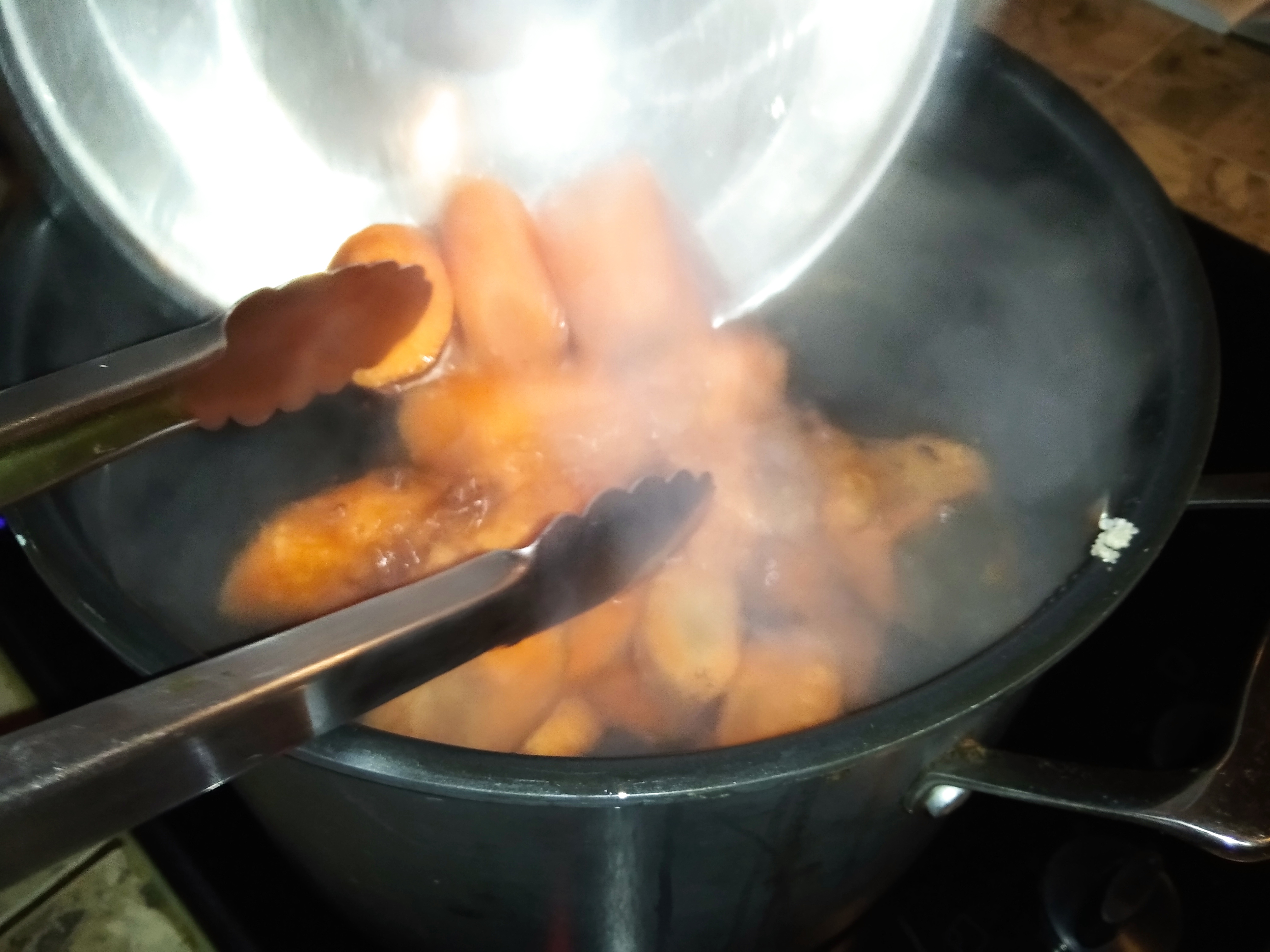
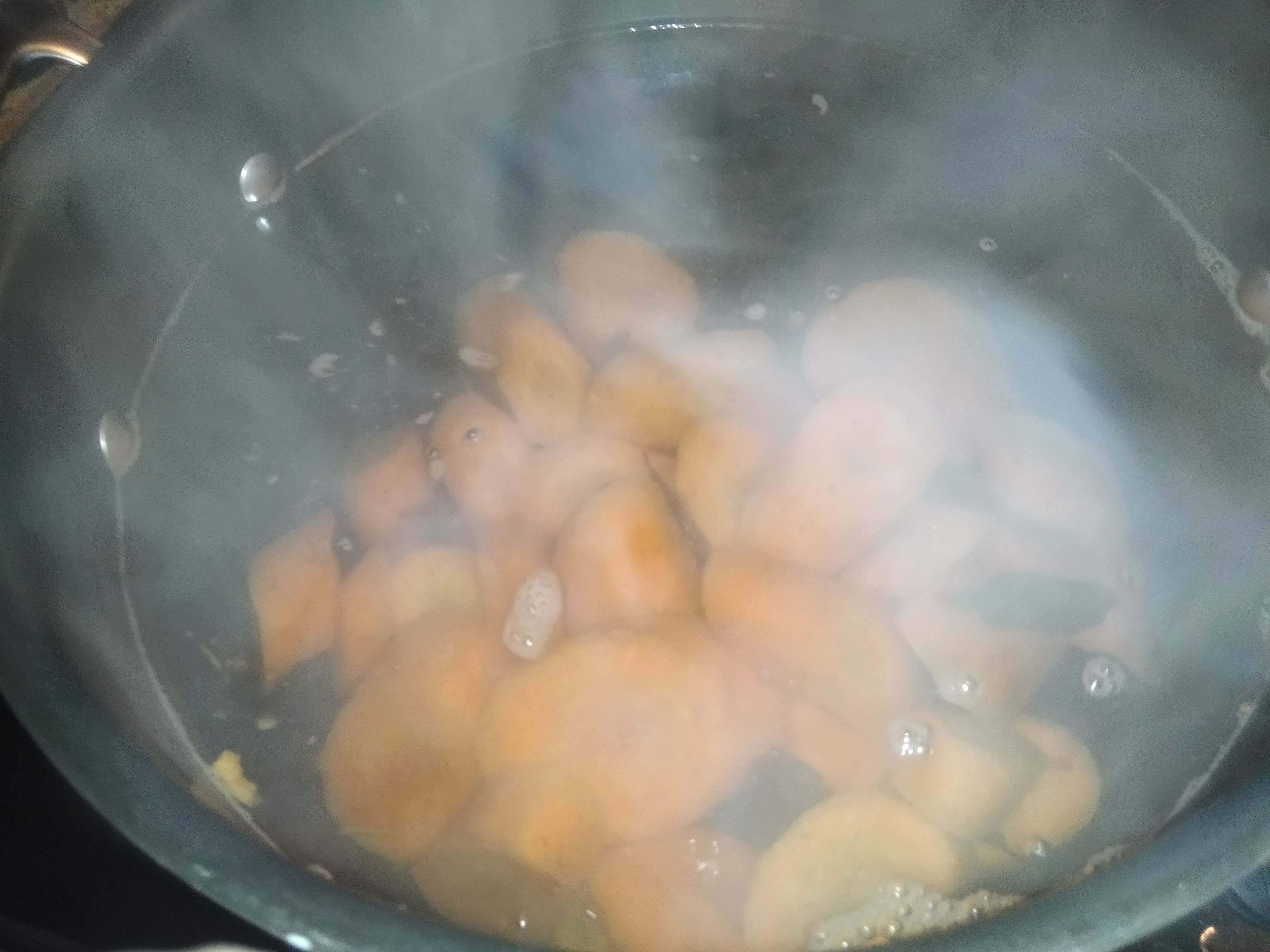
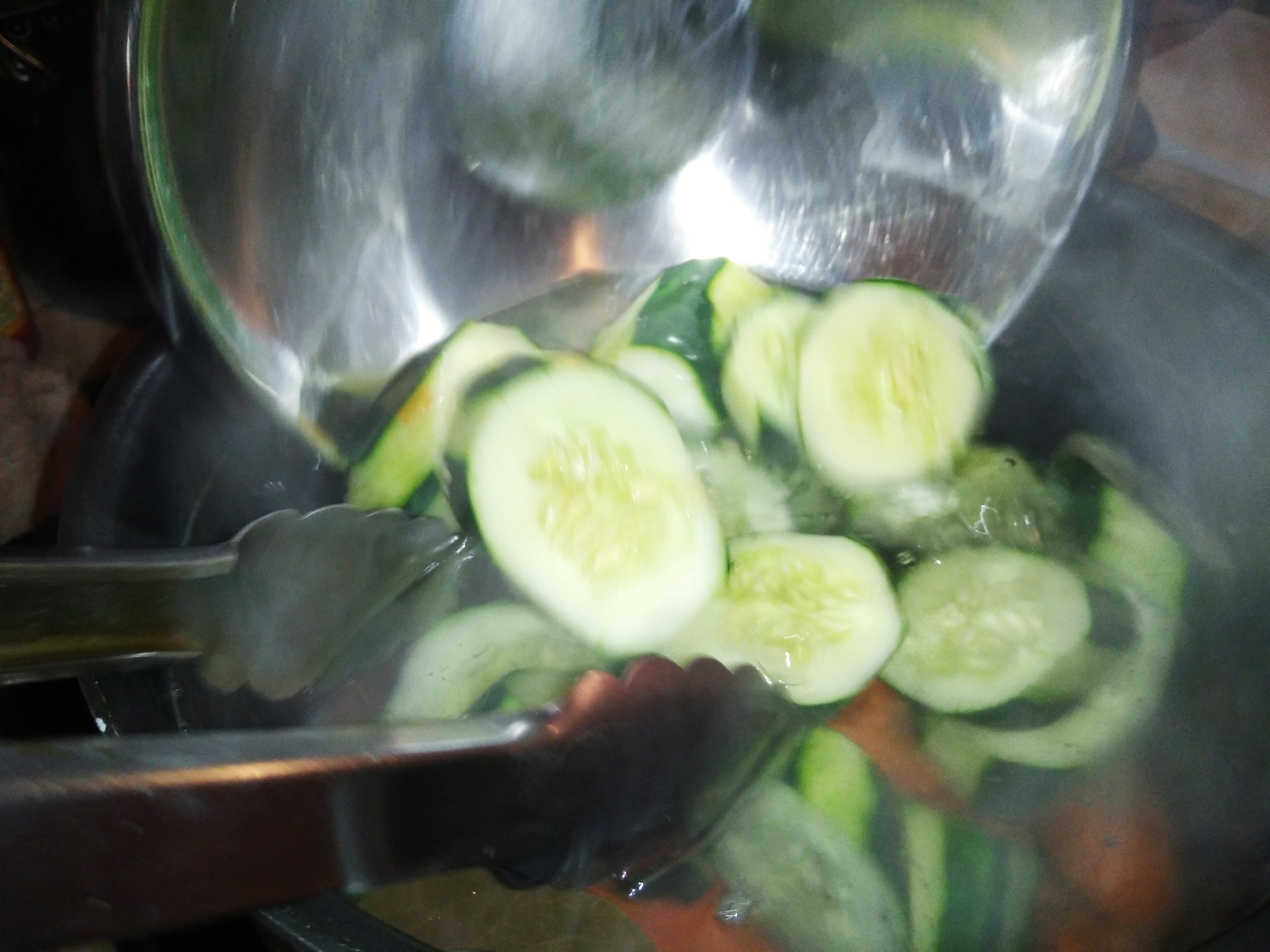
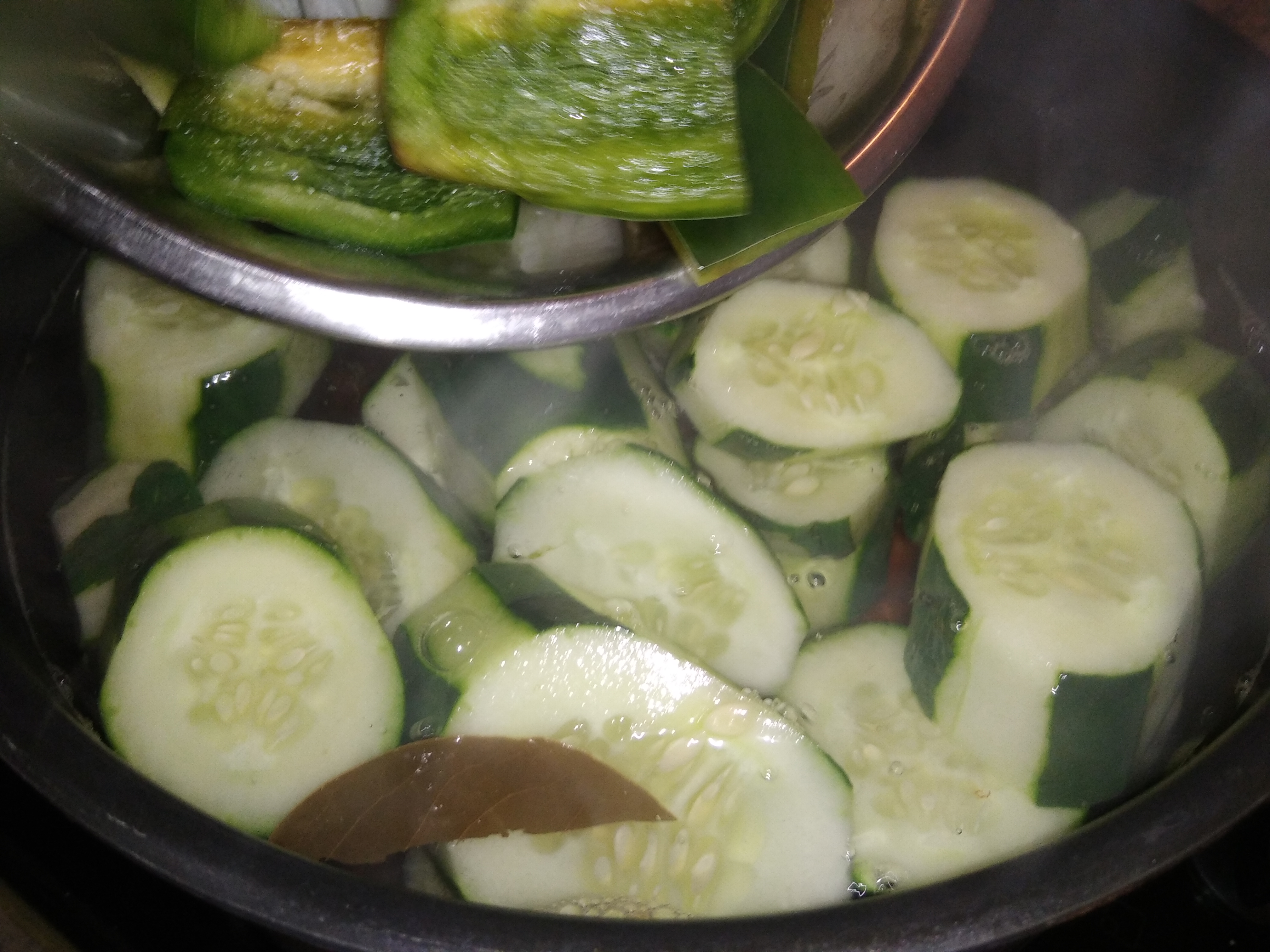

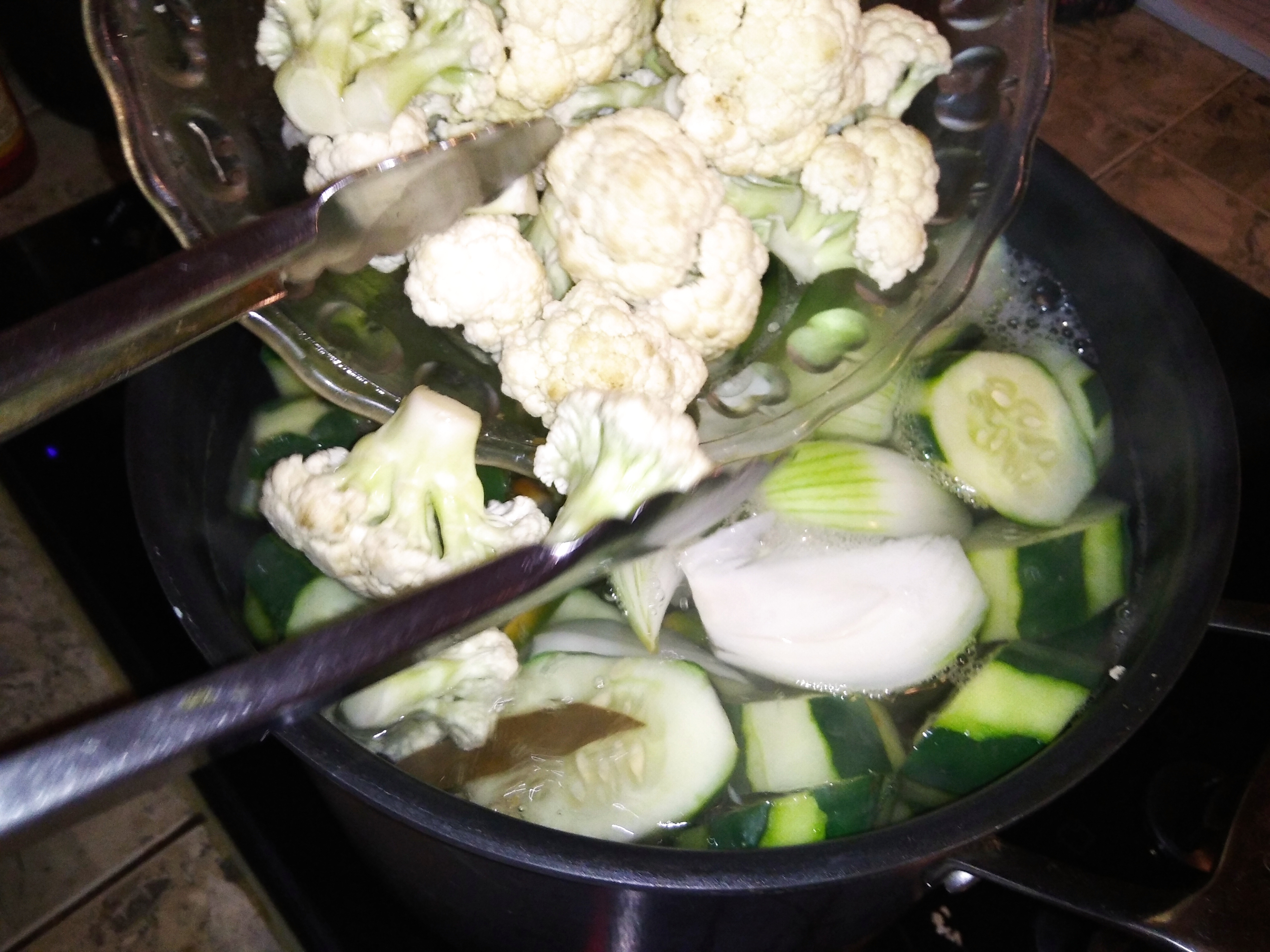
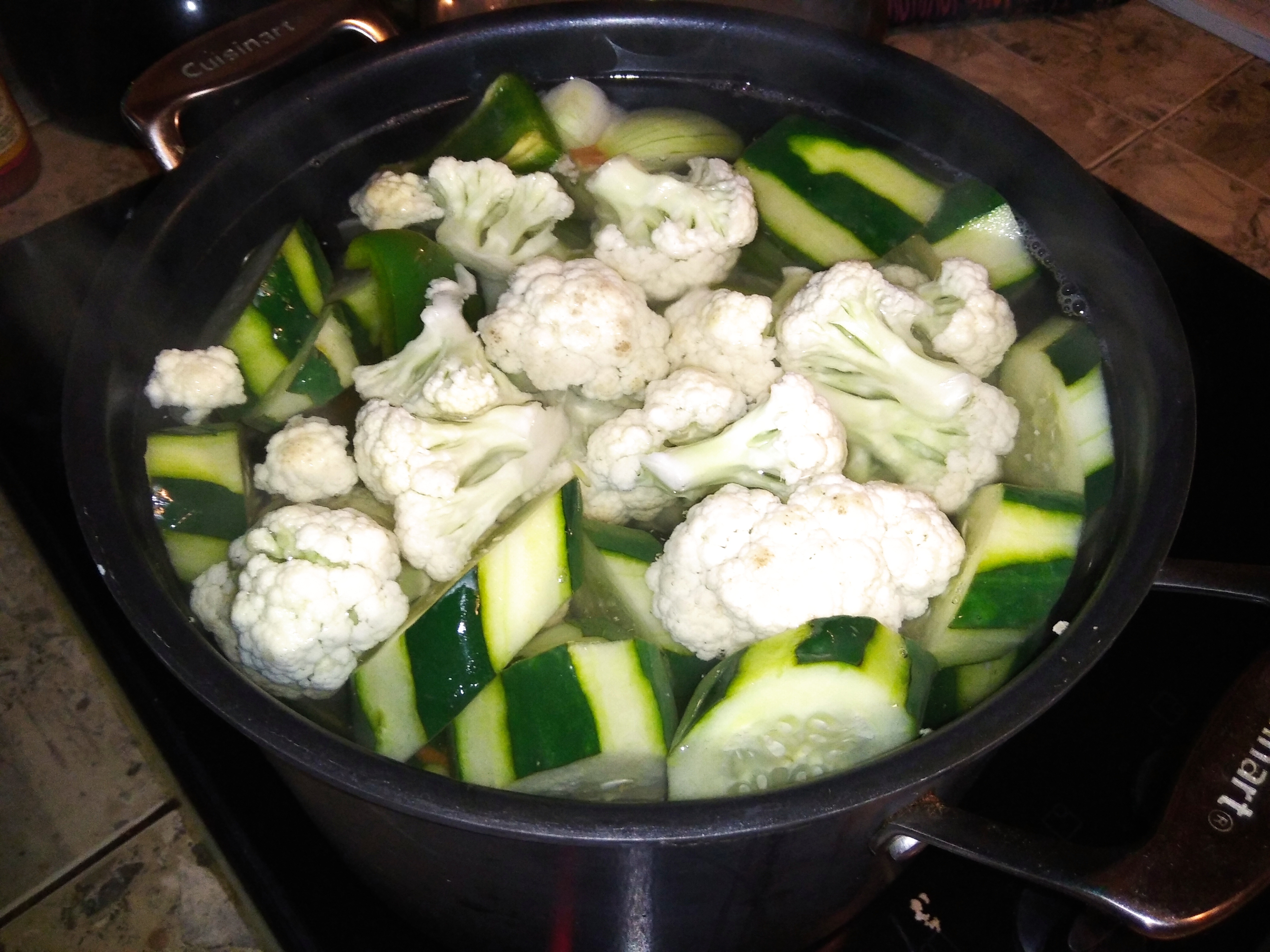

Paso 3
En algunas recetas encontraran que debemos retirar los vegetales, del líquido, sin perder el líquido, pues lo necesitaremos, pueden hacer esto, pero corren el riesgo de contaminar los vegetales, antes de envasarlos, así que yo prefiero retirarlos de a poco del líquido en el que hirvieron con una espumadera de acero inoxidable que he previamente esterilizado junto a los frascos, y ponerlos directamente en los frascos, recién sacados del agua hirviendo (donde habremos dejado las tapas), usando para ello una pinza, también de acero inoxidable y también esterilizada.
Luego de que hemos acomodado dentro de cada frasco una cantidad, variada y suficiente de vegetales, como para llenarlos hasta el cuello, usando un cucharon de acero inoxidable, esterilizado, agregaremos el líquido de encurtido en el frasco hasta cubrir por completo todos los vegetales.
Finalmente sacaremos las tapas del agua hirviendo, donde las habíamos dejado, y sin dejarlas enfriar y ayudados por la pinza y un trapo limpio, procederemos a tapar los frascos, ajustándolas lo mejor posible.
Es recomendable que el proceso de envasado lo hagamos en una superficie cubierta por un trapo, pues, además de que los frascos estarán calientes y mojados, inevitablemente se derramará líquido del encurtido cuando los llenemos.
Step 3
In some recipes you will find that we must remove the vegetables, from the liquid, without losing the liquid, because we will need it, you can do this, but you run the risk of contaminating the vegetables, before packing them, so I prefer to remove them little by little from the liquid in which they boiled with a stainless steel skimmer that I have previously sterilized along with the jars, and put them directly into the jars, just removed from the boiling water (where we will have left the lids), using for this a tongs, also stainless steel and also sterilized.
After we have placed enough vegetables in each jar to fill them up to the neck, using a sterilized stainless steel spoon, we will add the pickling liquid into the jar until all the vegetables are completely covered.
Finally we will take the lids out of the boiling water, where we had left them, and without letting them cool and helped by the tongs and a clean cloth, we will proceed to cover the jars, adjusting them as well as possible.
It is advisable to do the canning process on a surface covered by a cloth, since, in addition to the fact that the jars will be hot and wet, liquid will inevitably spill out of the pickle when we fill them.
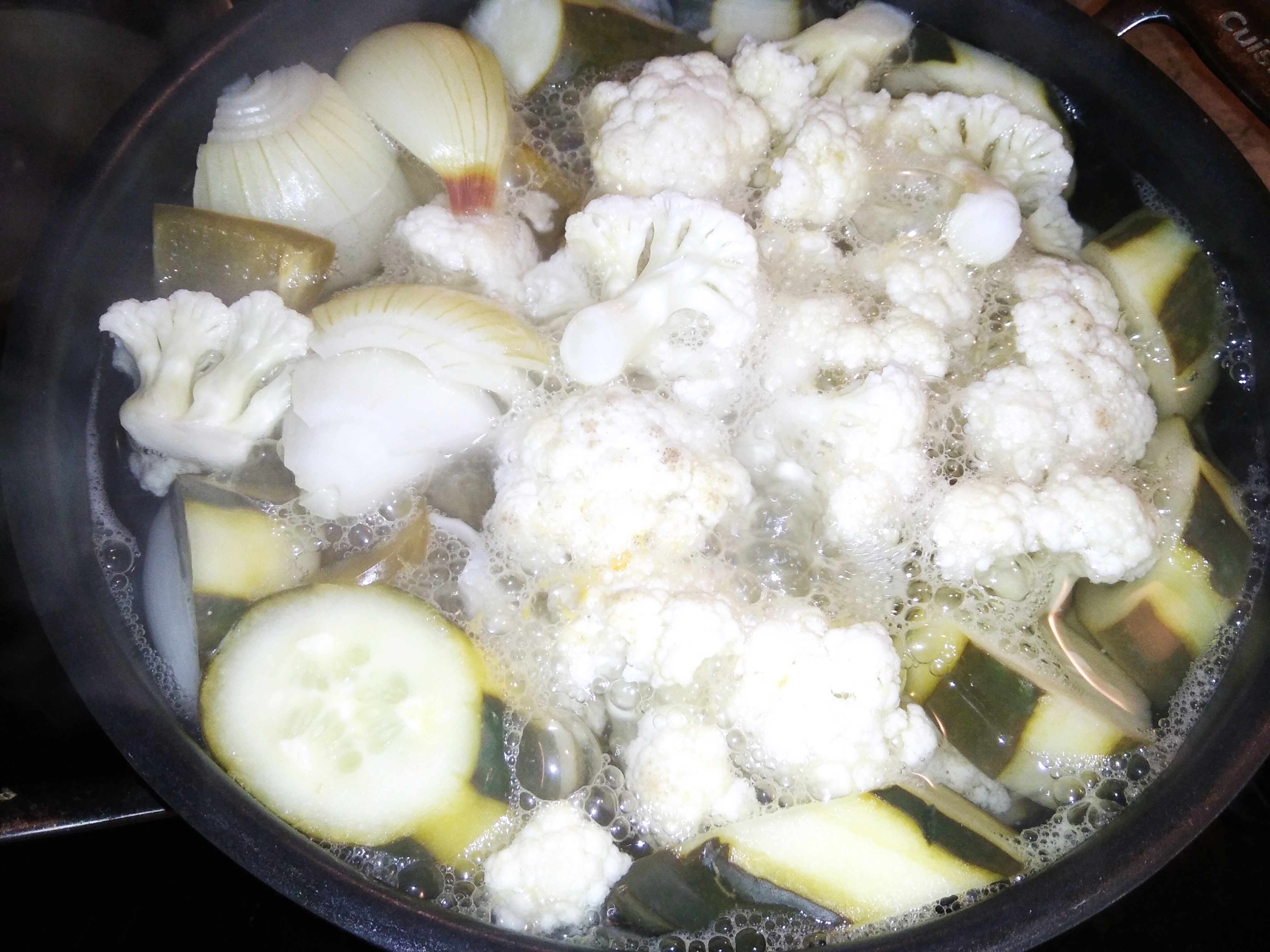

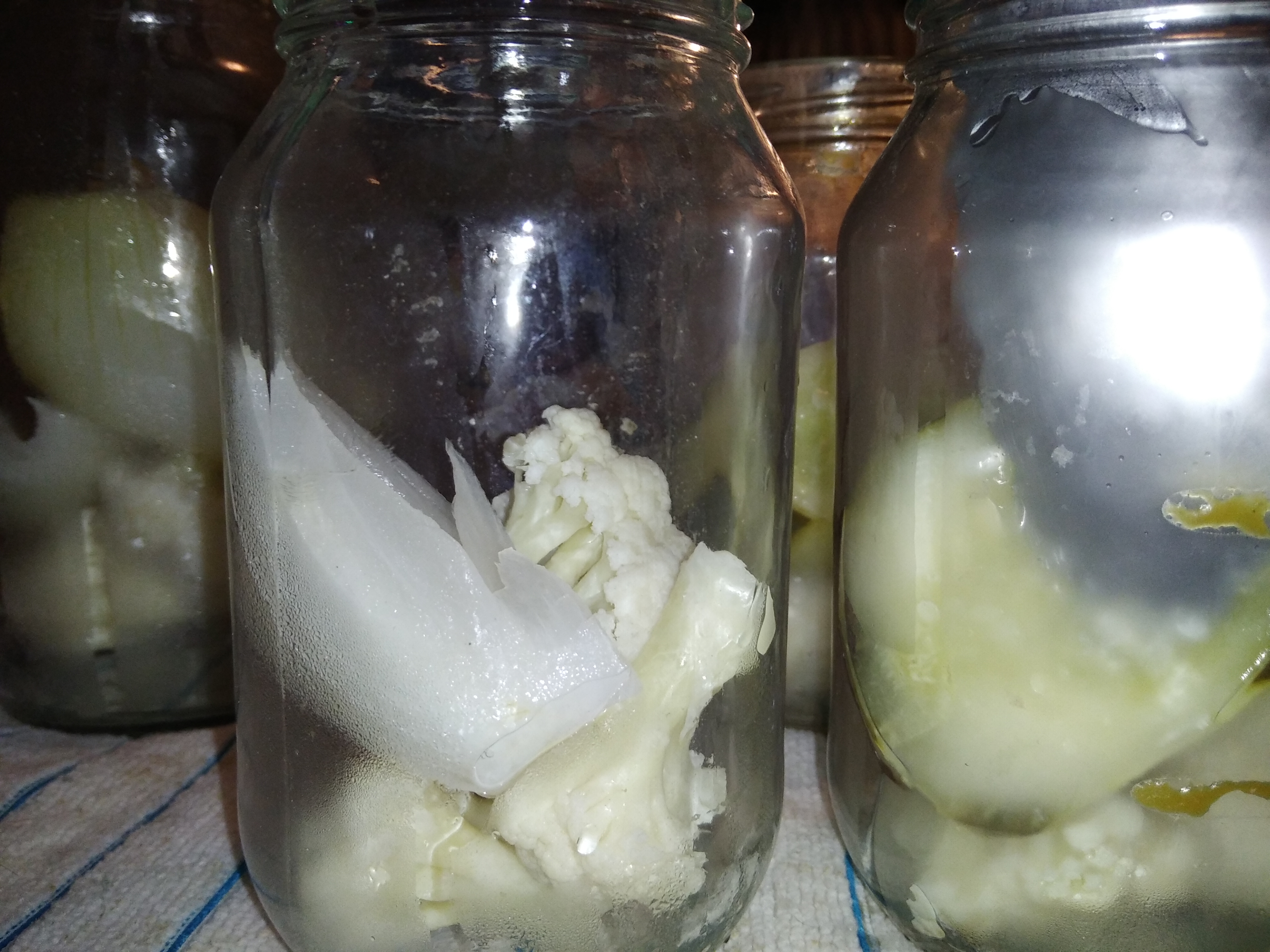
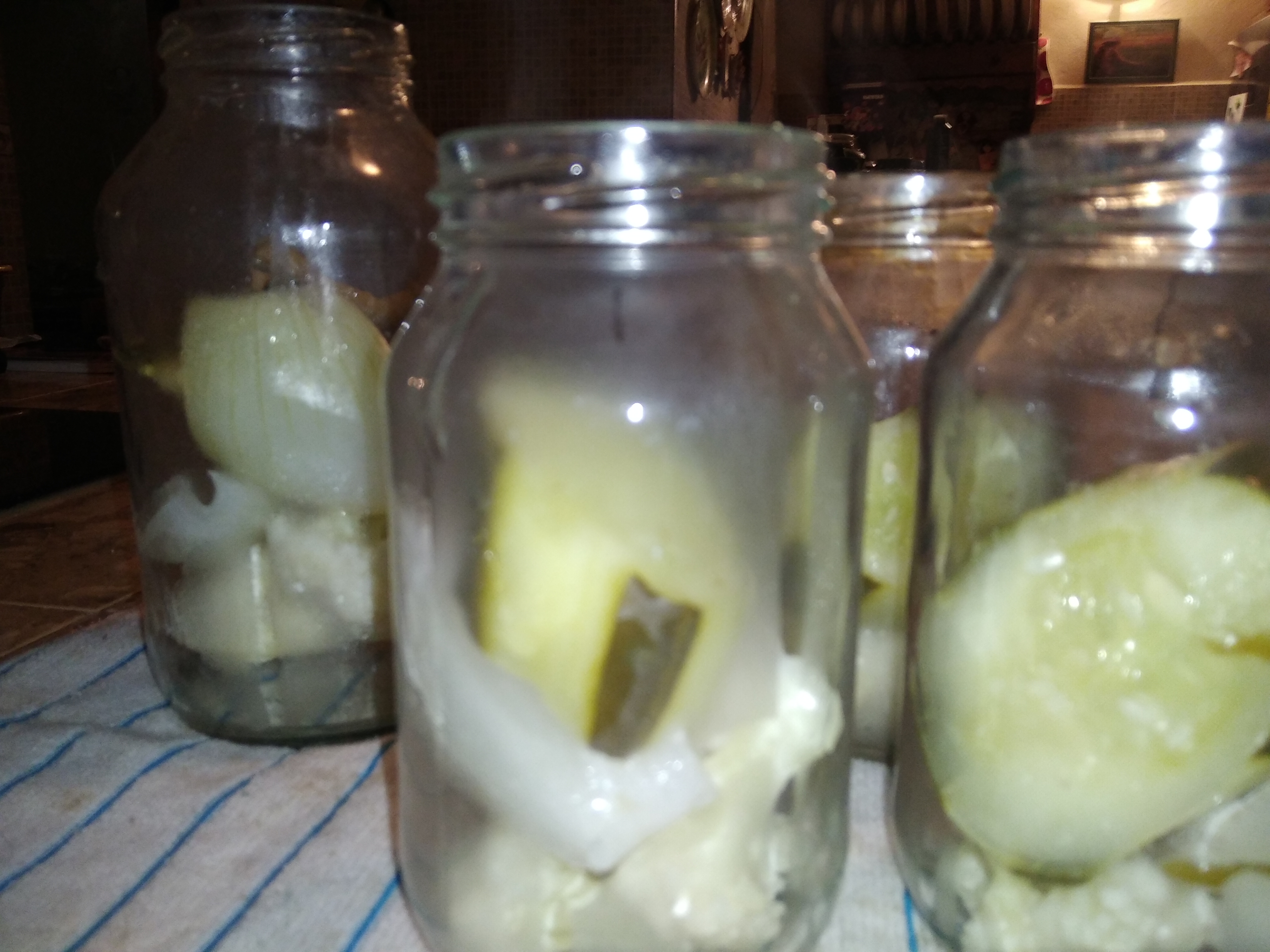
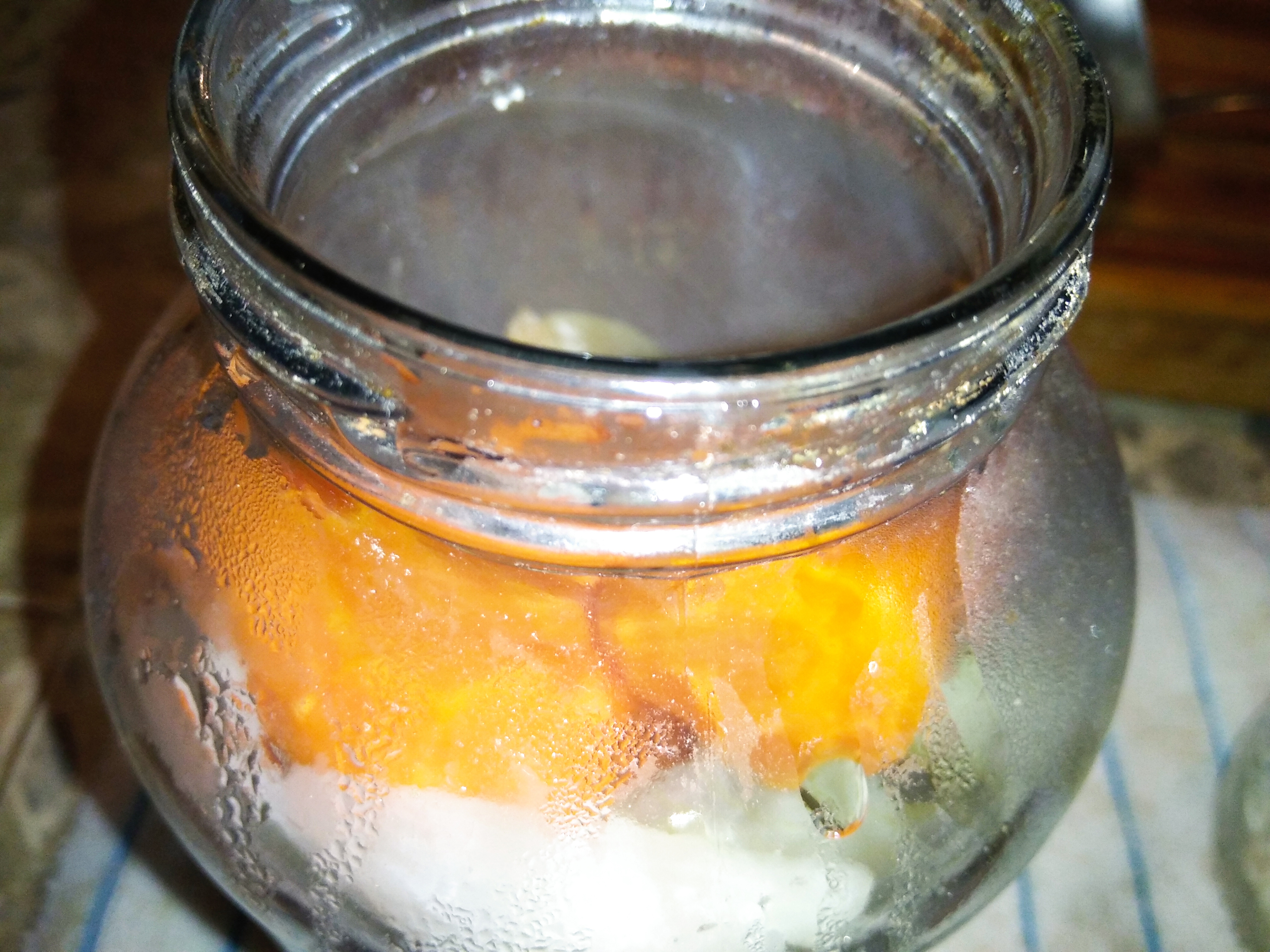


Finalmente, si como indique al principio usaron frascos con tapas de metal con cierre hermético, notaremos que a medida que nuestros frascos de encurtidos se enfrían, escucharemos como las tapas hacen el característico sonido "pop" cuando sus sellos se hunden.
Este mismo procedimiento de encurtido pueden usarlo para otros vegetales como brócoli, nabos, rábanos, remolachas, alcachofas, espárragos, etc. Lo que les permitirá conservarlos por varios meses, siempre que los guarden en lugares frescos y alejados de la luz directa. Espero que la técnica les sirva y puedan aplicarla.
Finally, if as I indicated at the beginning you used jars with metal lids with airtight seals, you will notice that as your pickling jars cool, you will hear the lids make the characteristic "pop" sound as their seals sink.
This same pickling procedure can be used for other vegetables such as broccoli, turnips, radishes, beets, artichokes, asparagus, etc. This will allow you to keep them for several months, as long as you store them in cool places and away from direct light. I hope this technique will be useful and that you will be able to apply it.






Espero que la receta les haya gustado, puedan prepararla y la disfruten, hasta la próxima.
I hope you liked the recipe, that you can prepare it and enjoy it, until next time.

Todas las fotografías fueron tomadas con un movil Redmi 8A
¡Que genial! Hace tiempo quise hacer pepinos encurtidos pero creo que solo hice un caldo de cultivos de bacterias jaja no trabajé con tanto cuidado, de hecho al final no me los comí. Me gustó mucho, lo intentaré.
Para que tomen el sabor a encurtido ¿Como cuanto tiempo habría que esperar para consumirlos?
Hola @tsunsica, normalmente nosotros los hacemos como un mes antes de empezar a usarlos, pero creo que como a los 15 dias ya deben haber tomado el sabor. Para hacer los pepinillos es recomendable usar un poco más de azucar así tomarán un sabor más agridulce.